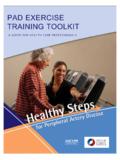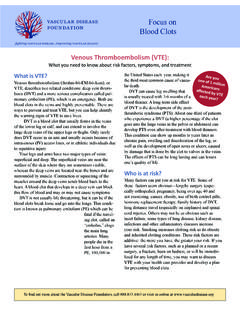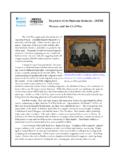Transcription of The Ever Changing Role of Diagnostic Testing - …
1 The Ever Changing Role of Diagnostic Testing Donna M Mendes MD, FACS Learning objectives Understand the reliability and cost effectiveness of: History and physical exam Non-invasive physiologic Testing Ultrasound for venous and arterial imaging Contrast utilizing imaging When to use: Non-invasive physiologic Testing Venous imagining tests Arterial imagining test Lymphatic imaging studies Understand the difference between functional Testing and imaging Understand the role for emerging technologies The History The Physical Exam Initial assessment A time to develop mutual trust between you and the person signing out to you Tailor to flow to the presenting problem, but should be comprehensive enough to understand the complete picture of the patient Remember test results (pulse exam)
2 Must be correlated with clinical impression If there is a discrepancy between the clinical impression and the findings the provider must develop a workable explanation General Vascular History Previous heart attack, angina, coronary intervention Previous arterial vascular surgery Medication reconciliation Leg swelling, history of DVT, history of venous surgery The History Venous History How long have the varicose veins been present How long has there been swelling How long has an ulcer been present The History Arterial history typical features Pain brought on by exercise, relieved by rest (claudication) Most commonly in the calf *Nocturnal cramps have no known vascular basis Pain in the forefoot at nighttime (rest pain)
3 In the diabetic patient a complete lack of pain is normal *Pain that is intermittently present in the foot or leg and occurs with exercise, BUT is also present at rest is not related to arterial disease Other differentials include: Osteoarthritis, Neurospinal compression, chronic compartment syndrome The History Lymphatic The duration of swelling of the leg When was the onset of symptoms Previous malignancy, previous surgery, previous radiotherapy CAROTID DUPLEX ULTRASOUND OR CAROTID DOPPLER Carotid duplex study- extracranial Indications TIA-transient ischemic attack CVA cerebrovascular accident Bruit Symptoms Amourosis Fugax Numbness/Weakness (unilateral)
4 Speech difficulty Dizziness Used as a frontline or screening test No prep for test and no harm to patient Internal carotid artery supplies 80% of the blood to the brain Vertebral arteries are the other 20% Diagnostic criteria Laboratory variability Incidence of CVA in the next year with intervention vs. conservative treatment Transcranial Doppler (TCD) Intracranial circulation This test is a Doppler only Recent advances have added M-mode doppler which increases the accuracy of the test and B-mode imaging with Color doppler: although imaging is not widely used and has serious limitations.
5 Indicatons CVA TIA Sickle cell anemia- as a tool to determine risk of TIA/CVA monitoring for vasospasm and vasculitis assessing initial collateral blood flow and embolization during carotid endarterectomy (shunt placement to reduce the risk of stroke) Evaluates the arteries the make up the Circle of Willis Upper extremity duplex ultrasound -arteries Indications Palmer arch assessment prior to radial artery harvesting for cardiac bypass surgery Suspected digital embolization Evaluation of A-V fistula/Hemodialysis grafts Arm Claudication Symptoms Cold hands/fingers (vasospasm/Raynaud s)
6 Non-healing finger wounds Hand or finger pain Problem with hemodialysis pressures/maturation Upper extremity duplex ultrasound - veins Indications Vein mapping prior to vascular or cardiac surgery,hemodialysis DVT (deep vein thrombosis) Symptoms Arm pain Acute or chronic swelling The Examination Palpation Temperature Cool suggest poor circulation Pitting edema Test on dorsum of foot, if present on the dorsum of the foot Capillary refill Should be less than 3 seconds The Examination Arterial pulses Dorsalis pedis artery pulse on the dorsal of the foot, running lateral to the tendon of the first toe missing in 10% of normals Posterior tibial artery pulse posterior and inferior to the medial malleolus Popliteal artery pulse behind the knee.
7 Typically done with both hands, examiner facing the patient. The patient needs to relax the leg Femoral artery pulse in the femoral triangle/halfway between the anterior superior iliac spine and pubic symphysis Femoral Easy to palpate May be obscured in obesity Can examine lymph nodes Femoral hernia Pulse Exam Lower Extremity Regents of the University of California Popliteal More difficult to palpate Femoral condyles/muscle Slightly flex and relax leg One hand Pop aneurysm Pulse Exam-LE Regents of the University of California PT Gentle pressure best Relax & dorsiflex ankle DP 2 hands to palpate
8 Absent in 10% May have lateral tarsal Pulse Exam-LE Regents of the University of California Lateral Tarsal May need to press through edema Calcified vessels Pulse Exam-LE Regents of the University of California The Hand Held Doppler Bedside Ankle Brachial Index Compare the systolic occlusion pressure of the brachial artery with the systolic occlusion pressure of the posterior tibial artery, and dorsalis pedis artery Artificially elevated in diabetes mellitus, chronic renal disease, old age Listen to the ultrasound Normal triphasic ultrasound Proximal disease biphasic ultrasound Severe monophasic ultrasound The Hand Held Doppler Inexpensive Widely available Does not offer detailed description of length, severity.
9 Or type of the diseased vessel Time and labor consuming The PAD screening score using the hand held Doppler has the greatest Diagnostic accuracy The Vascular Laboratory Arterial Plethysmography Noninvasive Extremity Pressure Measurements Doppler Waveform Analysis Transcutaneous Oximetry Goals of Testing Does the Patient Have Disease?---P=I How Does the Disease Relate to the Patient s Presentation?----P alone Where Is the Disease Located?----I>P What Are the Therapeutic Options?---I>>P What Are the Results of Therapy?---P alone P= physiologic I= imaging(Anatomic) From: Brenenati, JF, 2005 Physiologic Tests Ankle-Brachial Index (ABI) Pulse Volume Recordings, Segmental Plethysmography (PVRs) Exercise PVRs Does the patient have the disease, is it related to their symptoms, where is the general location of the disease Plethysmography A plethysmograph is a device that measures or records variations in.
10 The volume of an organ or extremity The blood contained in or passing through Most commonly used Segemental air plethysmography Segmental Air Plethysmography The change in volume of an extremity between systole and diastole The change in volume is completely dependent upon pulsatile blood flow The Pulse Volume Recording (PVR) was developed in the 1970s specifically for arterial diagnosis The cuffs are off appropriate diameter to the location on the limb They are inflated to 65 mmHg to ensure appropriate contact between the cuff and the extremity PVRs Pneumatic cuffs of specific size placed at thigh, calf, ankle.
















